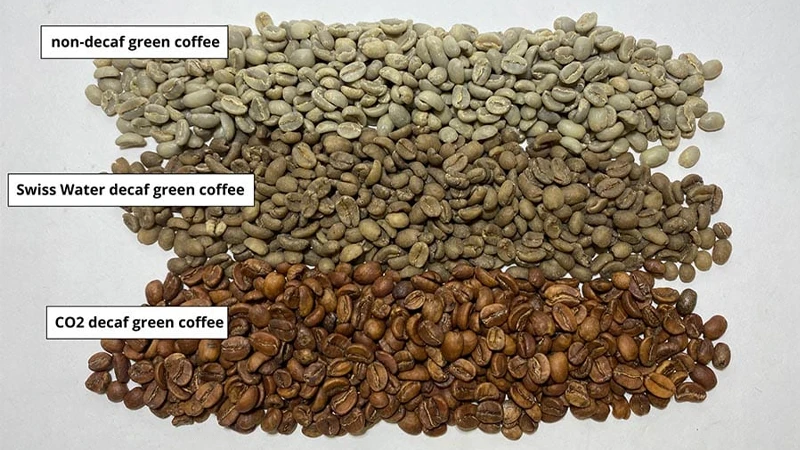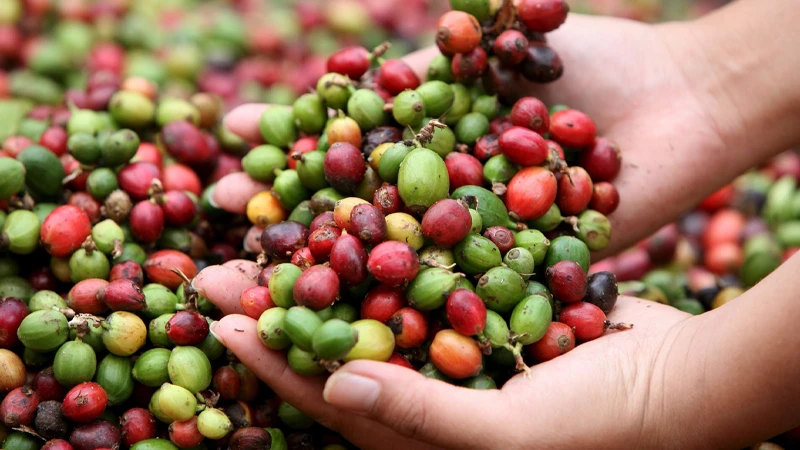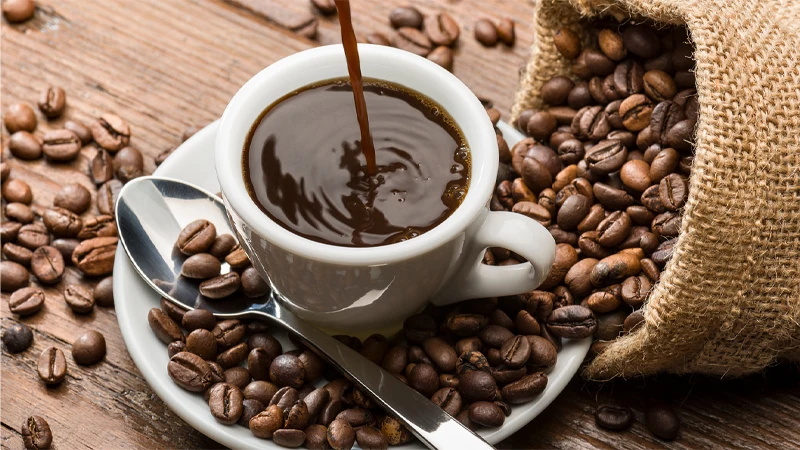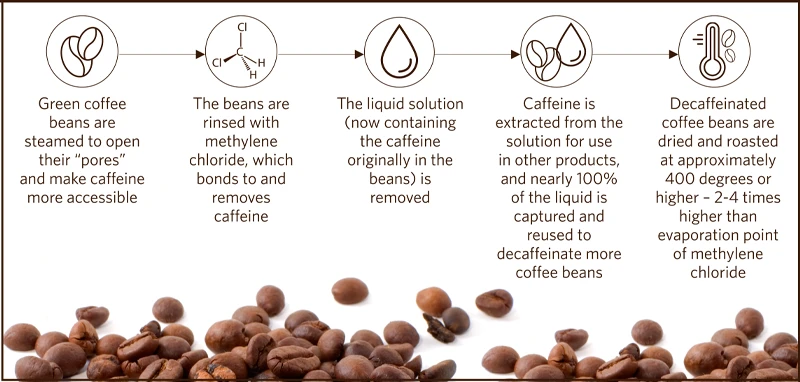Often just known as “decaf, decaffeinated coffee is manufactured from beans that have been processed to eliminate most of their caffeine content while maintaining the distinctive taste and scent of regular coffee.
Decaf lets coffee drinkers enjoy their preferred drink free from the stimulating effects that could disrupt sleep, raise heart rate, or induce jitters by eliminating about 97% of the naturally occurring caffeine. While not totally free of caffeine, a standard 8-ounce decaf cup only has 2–15 mg compared to roughly 95 milligrams in a regular cup.

What is decaf coffee?
Often just known as “decaf,” decaffeinated coffee is coffee that has been specially processed to eliminate much of its naturally occurring caffeine while maintaining most of the original taste, aroma, and body of the bean.
Decaf usually has about 2–15 milligrams of caffeine per 8-ounce cup, unlike ordinary coffee, which delivers an average of 95 milligrams of caffeine. This makes it an attractive option for individuals who prefer to cut their stimulant intake without sacrificing the custom of making and drinking coffee.
Green, unroasted coffee beans that are completely hydrated start the decaffeination process, which lets caffeine be more readily removed. Once the moisture is included, the beans are exposed to one of several techniques—each intended to specifically target and eliminate caffeine molecules while doing little damage to the taste chemicals. After treatment, the beans are dried back to their original moisture content and then roasted just like conventional coffee, producing a cup that looks and performs like ordinary coffee in a brewer, however is milder on the nervous system.
Early in the 20th century, German coffee vendor Ludwig Roselius developed the first commercial technique following inadvertent discovery that sea-water soaked beans created a less stimulating drink.
Several refining methods have been developed over the years to improve caffeine elimination without compromising taste.
- The Swiss Water Process, which relies on solubility and charcoal filtration to collect caffeine molecules, employs water and osmosis to wash out caffeine.
- Solvent-based techniques soak the beans briefly using food-grade solvents such ethyl acetate or methylene chloride, then steam them to remove any leftover chemicals.
- Supercritical carbon dioxide, which under high pressure serves as a selective solvent for caffeine and can be recycled inside a closed-loop system, is more modern and environmentally beneficial method of use.
Every technique strikes a distinct mix between cost, environmental effect, flavor preservation, and efficiency; coffee growers typically select the one that most fits their sustainability objectives and quality criteria.

Where does caffeine come from?
Produced naturally by more than 60 different plant species, caffeine provides a chemical defense against pests including mosquitoes. In coffee, it gathers in the seeds—or beans—of Coffea arabica and Coffea canephora (Robusta) trees. These evergreen bushes do best in tropical, high-altitude areas with rich soil and consistent rainfall—places like Brazil, Colombia, Ethiopia, and Vietnam. Coffee cherry ripens cause caffeine levels in the bean to peak, ready for extraction later during brewing.
Besides coffee, caffeine exists in tea leaves (Camellia sinensis), cocoa pods (Theobroma cacao), yerba mate (Ilex paraguariensis), guarana berries (Paullinia cupana), and kola nuts (Cola acuminata). Caffeine content varies among sources; Arabica beans typically contain 1–1.5%; robusta beans can reach up to 2.7% caffeine by weight.
Coffee cherries are either sun-dried whole (natural method) or pulped and fermented before drying (washed method), although in both cases the caffeine stays contained inside the green bean until decaffeining.
Hot water dissolves caffeine along with aromatic oils and acids when you make coffee, therefore offering both the complex taste millions of people enjoy daily and the stimulating impact. While the source of the stimulant—nature’s own defensive chemistry—remains unaltered in decaf coffee, that caffeine is selectively removed beforehand.

What is the point of decaffeinated coffee?
Without most of the stimulation of caffeine, decaffeinated coffee provides all the ritual, taste, and mouthfeel of regular coffee. Those recommended to cut their intake during pregnancy or owing to medical issues like hypertension or acid reflux as well as anyone who suffers unfavorable reactions to caffeine—such as anxiety, restlessness, insomnia, or an elevated heart rate—should find it particularly helpful.
Decaf reduces jitters and sleep disturbance by eliminating almost 97% of the caffeine, thereby enabling you to enjoy a warm cup at any hour.
Beyond its low-caffeine profile, decaf keeps several of coffee’s helpful bioactive compounds—including polyphenols and antioxidants, that promote liver and metabolic function. Studies relate decaf intake to lower risk of type 2 diabetes and better insulin sensitivity as well as preventive effects against non-alcoholic fatty liver disease and cardiovascular problems.
Furthermore, the revolution in specialty coffee has embraced sustainable packaging and mild, ecologically friendly decaffeining techniques (such as the Swiss Water and CO₂ procedures), so modern decafs satisfy both health-conscious consumers and those with environmental concerns.

Differences between decaffeinated and caffeinated coffee
While ordinary coffee gives around 70–140 mg in the same serving size, decaffeinated coffee usually has just 2–15 mg of caffeine per 8-ounce cup. Regular coffee frequently increases alertness, mood, and metabolic rate since caffeine is a central nervous system stimulant; decaf’s low caffeine content produces either very little or no stimulating impact.
Along with some volatile fragrance components and acids, the decaffeining process can also remove acids, therefore producing a somewhat gentler, less strong flavor and a lighter body than their caffeinated counterparts. Studies reveal brewed decaf pH ranges from 5.14 to 5.80 compared 4.95 to 5.99 for regular coffee; decaf generally shows lower acidity (greater pH). This makes it milder on sensitive stomachs. Specialty decaf products made using mild, chemical-free techniques, such as the Swiss Water or supercritical CO₂ processes, preserve more of the original taste nuances and mouthfeel, so closing the sensory difference between decaf and regular drinks.
Both decaf and regular coffee retain most of coffee’s beneficial bioactive compounds—antioxidants and polyphenols—linked to health benefits like improved insulin sensitivity and liver protection. Decaf may be preferable for individuals with caffeine sensitivity, acid reflux, or hypertension, as it minimizes vascular and gastrointestinal effects while still delivering those protective phytochemicals.
However, the extra decaffeination step—often involving shipment to specialized facilities and additional processing—can increase production costs, leading retail decafs to command higher prices than regular coffee . Despite this, demand remains strong among health‑ and sleep‑conscious consumers, driving continued innovation in decaf quality and sustainability.
Conclusion
Decaffeinated coffee offers an excellent option for those looking to enjoy the taste and experience of coffee without the stimulating effects of caffeine. Whether due to health concerns, caffeine sensitivity, or simply a desire to savor coffee at any time of day, decaf provides a comforting alternative that aligns with modern wellness goals.
As decaf coffee quality continues to improve, more brands are paying attention not only to flavor but also to sustainability—from ethically sourced beans to eco-conscious packaging. At BN PACK, we are proud to support this movement by providing high-quality, eco-friendly packaging solutions tailored for the coffee industry. Our compostable, biodegradable, and recyclable coffee bags are designed to protect product freshness while reducing environmental impact—making them the perfect match for specialty decaf products that prioritize both quality and sustainability.
Whether you’re a roaster looking to expand your decaf line or a brand committed to greener practices, BN PACK offers packaging solutions that complement your coffee’s story—one that’s flavorful, thoughtful, and responsibly made.
